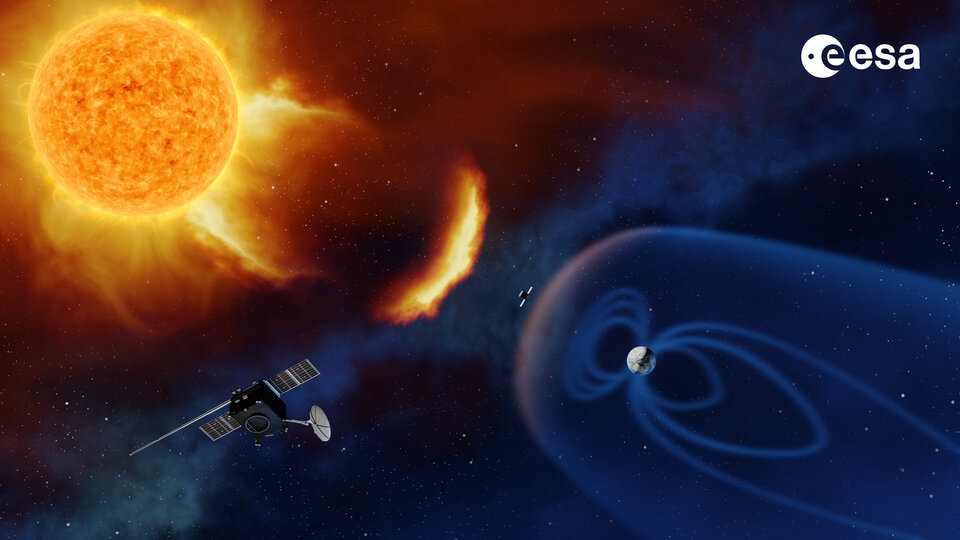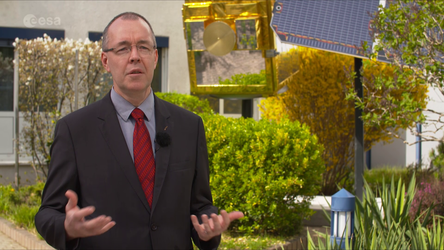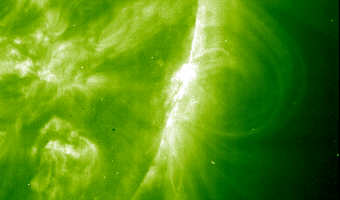ESA's Portal to the Sun gets an upgrade
ESA’s Space Weather Network can be thought of a little like Europe’s ‘stellar agony aunt’. Although the Network is unable to affect the Sun’s outbursts, it provides support, predictions and up-to-date information to people, businesses and institutions that are often affected and sometimes threatened by the behaviour of our star, on which our modern lives rely.
The Space Weather Portal is the online component of this space weather service, and it recently underwent a major upgrade. The Portal consists of hundreds of free resources for public and specialist audiences to better understand current and future space weather – the changing conditions in space as a result of the tumultuous behaviour of the Sun – and how this could impact us on Earth.
Why this matters

As part of a study commissioned by ESA’s Space Safety Programme (formally the Space Situational Awareness Programme) in 2016, the potential cost to Europe of space weather events was estimated.
The study found that a single extreme solar event could cost 15 billion Euros, combining the effects to spacecraft operations, aviation, power distribution networks, road transportation and logistics among others. That was in 2016, and that cost was predicted to increase as we become more reliant on such technologies, rising to more than 20 billion Euros in 2024.
As such, our need for accurate and reliable space weather information is increasing, and here the Space Weather Service Network is unique, as the only distributed system of its type. Bringing together more than 40 different institutes and organisations to participate in the development and provision of its services, the Space Weather Portal is the central access point to the network’s space weather expertise, latest data, nowcasts and forecasts from across Europe.
What the portal provides
On the portal homepage a variety of graphs, graphics, maps and observations of the Sun portray the current conditions in space, from data on the interplanetary medium and the solar wind to - closer to home - Earth’s atmosphere and geomagnetic environment.

The site focuses on 12 areas, or “domains” that are affected by the Sun, including spacecraft operation and human spaceflight, pipeline operations, terrestrial radio communications, power systems, aviation and even aurora hunters.
Under each domain, visitors to the site will find forecasts on how the weather in space could affect their operations, now and in the future. For example, aviation, where a range of space weather phenomena can affect both aircrew and technical infrastructures.
The health of aircrews can be affected by increased radiation exposure, mainly caused by Galactic Cosmic Rays and occasional eruptions of Solar Energetic Particles. Space weather can also cause aviation infrastructure to degrade, or lead to loss of communication and navigation signals, as well as errors on-board aeroplanes.

Such disruptions can be caused by both electromagnetic and charged particle radiation, as well as changes in ionospheric conditions.
ESA’s Space Weather service for aviation aims at providing access to global information, data, models and tools addressing these issues to help pilots and ‘airline dispatchers’ in flight planning.
Many other fields can find similar information catered to their needs, including those working with power grids, pipelines, spacecraft, monitoring space debris and exploring the Solar System. Aurora hunters too, for example, can find regional information on the best time and place to spot the aurora – the beautiful and harmless manifestation of space weather processes.
Many of the products and tools which can be accessed via the portal can be used independently, but bringing them together and grouping them into user driven services provides a complete picture of ongoing and upcoming space weather conditions relevant for a particular user group based on state-of-the art scientific results and expert analysis. “Users” of the portal can also personalise it as they wish, combining its elements in flexible ways through, for example, tailored bulletins and dashboards.
Aside from models, predictions and datasets, the portal also provides access to space weather experts across Europe, as well as guidance and training through dedicated courses and online webinars.
How does it work?


Access the video
“Solar forecasting is a challenging business, much like weather forecasting on Earth,” explains Alexi Glover, Space Weather Service Coordinator at ESA.
“We have numerous tools available that use the latest scientific knowledge in order to provide an indication of the Sun’s current condition and how this may evolve. These tools are publicly available via the portal, and many are also used by expert forecasters to provide an overall assessment and forecast of how they expect conditions to evolve.”
These expert assessments are available on the Portal and also make up part of the tailored bulletins issued to certain users in case of disturbed conditions. These expert summaries, combined with the large amount of data and information available, provide users with a wealth of information about current space weather conditions.
Where does the information come from?

The information which together constitutes ESA’s Space Weather Services comes from a wide range of space- and ground-based sources.
Missions such as the ESA/NASA SOHO observatory provide critical data alerting us to the onset of potentially hazardous events at the Sun and ESA’s Proba-2 mission also provides valuable information about solar activity.
Ground-based data, too, plays an important role, from ground-based magnetometers measuring rapid local fluctuations in Earth’s magnetic field, to ‘ionosondes’ – a special radar for the examination of the ionosphere – the ionized (charged) part of Earth's upper atmosphere, probing the ionised part of the upper atmosphere and providing essential information on how radio signals may propagate under current conditions.
In the future, ESA’s Lagrange mission to monitor the Sun will substantially improve the network's forecasting abilities, providing timely data from the unique 5th Lagrange point.

“L5 is an excellent spot for this space weather mission because it gets a “side view” of what’s happening at the Sun, giving us time to prepare before any potentially dangerous regions rotate into view as seen from Earth,” says Juha-Pekka.
“The spacecraft will provide crucial data that will help us spot Earth-arriving ejections, improve our forecasts of the arrival time at Earth and provide advance knowledge of active regions on the Sun.”
Used in combination with data from NASA’s upcoming Space Weather Follow On-Lagrange 1 mission (SWFO-1), located at the first Lagrange point, L1, and along with advanced modelling, data from ESA’s future mission promises to enable big steps forward in our ability to accurately forecast major space weather disturbances before they reach Earth.
Register for free
Registration for the space weather portal is free and only takes a few minutes. Feedback is also welcome from anyone using the Services via the online questionnaire.














 Germany
Germany
 Austria
Austria
 Belgium
Belgium
 Denmark
Denmark
 Spain
Spain
 Estonia
Estonia
 Finland
Finland
 France
France
 Greece
Greece
 Hungary
Hungary
 Ireland
Ireland
 Italy
Italy
 Luxembourg
Luxembourg
 Norway
Norway
 The Netherlands
The Netherlands
 Poland
Poland
 Portugal
Portugal
 Czechia
Czechia
 Romania
Romania
 United Kingdom
United Kingdom
 Slovenia
Slovenia
 Sweden
Sweden
 Switzerland
Switzerland





































